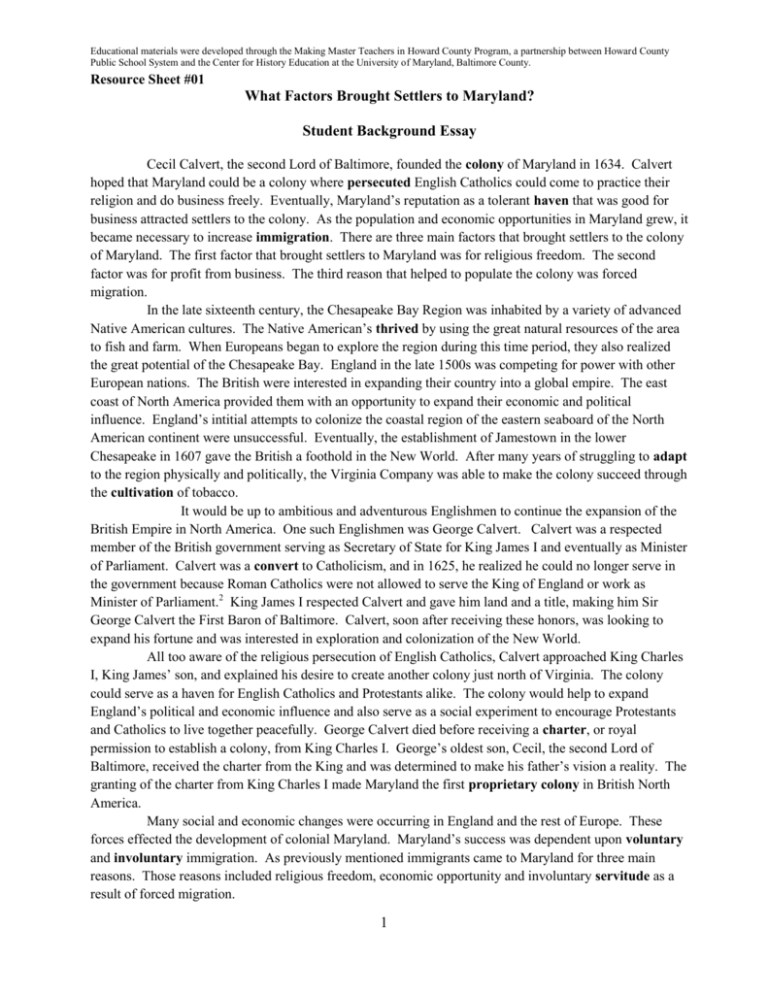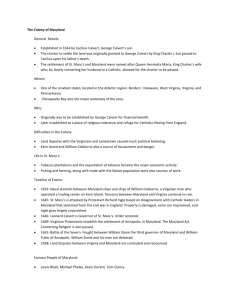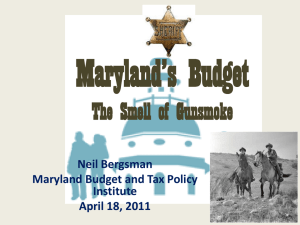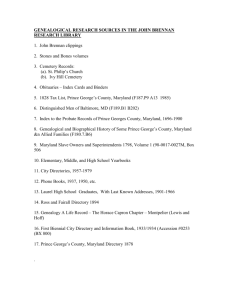1 What Factors Brought Settlers to Maryland? Student
advertisement

Educational materials were developed through the Making Master Teachers in Howard County Program, a partnership between Howard County Public School System and the Center for History Education at the University of Maryland, Baltimore County. Resource Sheet #01 What Factors Brought Settlers to Maryland? Student Background Essay Cecil Calvert, the second Lord of Baltimore, founded the colony of Maryland in 1634. Calvert hoped that Maryland could be a colony where persecuted English Catholics could come to practice their religion and do business freely. Eventually, Maryland’s reputation as a tolerant haven that was good for business attracted settlers to the colony. As the population and economic opportunities in Maryland grew, it became necessary to increase immigration. There are three main factors that brought settlers to the colony of Maryland. The first factor that brought settlers to Maryland was for religious freedom. The second factor was for profit from business. The third reason that helped to populate the colony was forced migration. In the late sixteenth century, the Chesapeake Bay Region was inhabited by a variety of advanced Native American cultures. The Native American’s thrived by using the great natural resources of the area to fish and farm. When Europeans began to explore the region during this time period, they also realized the great potential of the Chesapeake Bay. England in the late 1500s was competing for power with other European nations. The British were interested in expanding their country into a global empire. The east coast of North America provided them with an opportunity to expand their economic and political influence. England’s intitial attempts to colonize the coastal region of the eastern seaboard of the North American continent were unsuccessful. Eventually, the establishment of Jamestown in the lower Chesapeake in 1607 gave the British a foothold in the New World. After many years of struggling to adapt to the region physically and politically, the Virginia Company was able to make the colony succeed through the cultivation of tobacco. It would be up to ambitious and adventurous Englishmen to continue the expansion of the British Empire in North America. One such Englishmen was George Calvert. Calvert was a respected member of the British government serving as Secretary of State for King James I and eventually as Minister of Parliament. Calvert was a convert to Catholicism, and in 1625, he realized he could no longer serve in the government because Roman Catholics were not allowed to serve the King of England or work as Minister of Parliament.2 King James I respected Calvert and gave him land and a title, making him Sir George Calvert the First Baron of Baltimore. Calvert, soon after receiving these honors, was looking to expand his fortune and was interested in exploration and colonization of the New World. All too aware of the religious persecution of English Catholics, Calvert approached King Charles I, King James’ son, and explained his desire to create another colony just north of Virginia. The colony could serve as a haven for English Catholics and Protestants alike. The colony would help to expand England’s political and economic influence and also serve as a social experiment to encourage Protestants and Catholics to live together peacefully. George Calvert died before receiving a charter, or royal permission to establish a colony, from King Charles I. George’s oldest son, Cecil, the second Lord of Baltimore, received the charter from the King and was determined to make his father’s vision a reality. The granting of the charter from King Charles I made Maryland the first proprietary colony in British North America. Many social and economic changes were occurring in England and the rest of Europe. These forces effected the development of colonial Maryland. Maryland’s success was dependent upon voluntary and involuntary immigration. As previously mentioned immigrants came to Maryland for three main reasons. Those reasons included religious freedom, economic opportunity and involuntary servitude as a result of forced migration. 1 Educational materials were developed through the Making Master Teachers in Howard County Program, a partnership between Howard County Public School System and the Center for History Education at the University of Maryland, Baltimore County. The religious factor is an important element to understanding the founding and expansion of colonial Maryland. It was George Calvert’s vision of a place for English Catholics to practice their religion without social and economic persecution. The first colonists arrived in Maryland in 1634 on two ships named the Arc and the Dove. Soon after, Maryland’s reputation for religious tolerance motivated many Catholics throughout the British Isles to emigrate. Maryland was a place for both profit and worship. It was also an opportunity for Catholics to introduce their religion to the Native population of the region. Religious conversion of Native Americans was encouraged but was not a major goal of colonization in Maryland. The economic factor is essential in understanding the expansion of the British Empire. England, an island nation with limited resources, wished to compete for power in Europe. There was little choice but for her to venture far to gather necessary natural resources. As England’s industrial economy began to increase it was important to acquire colonies. The colonies provided British industry with the raw materials it needed to expand and thrive. The raw materials were turned into manufactured goods and sold within Britain and Europe and exported to the colonies. This economic cycle was called mercantilism and was the driving force behind European colonial expansion during the sixteenth and early seventeenth centuries. It was Maryland’s economic potential and success that would ensure its future as a haven for Catholics. Indentured servitude was an economic factor that drew immigrants to Maryland and provided them with an opportunity to relieve them of debt. Indentured servants were people, often poor, that were required by contract to work for a specific number of years, usually five to seven, in order to pay off their debt in Europe or the cost of their passage to the New World. At the end of their period of service, servants were given 50 acres of land, clothing, a year supply of corn, and tools and other sundries. Indenture may not have been the most pleasant experience, but it presented opportunities for people that otherwise would not have existed. The fact that a poor individual from the lowest class of European society could be granted land, the key to economic success and independence, was unthinkable back in Europe. The third reason, forced migration, is perhaps the least explored as a contributing factor to populating colonial Maryland. The vast majority of those forced to the New World were African. Eventually, millions of Africans would be kidnapped and transported to the New World via the Middle Passage. The successful tobacco plantations of Maryland required many laborers. Eventually, it’s estimated that some 500,000 Africans were transported to the thirteen colonies. Many Africans were brought to toil on the “tobacco coast” of Virginia and Maryland. Africans may have been unwilling immigrants to Maryland, but their contributions were critical to its growth and success. Many white Europeans were also forced to migrate to the New World. As previously mentioned, indentured servants voluntarily came to the colonies, while others were forced by financial circumstances. Still other whites were forced to emigrate by the British court system. In the 1650s Britain began regularly shipping convicts to its colonies in North America. In 1718 Parliament authorized involuntary transport of convicts to Britain’s colonies. Eventually, tens of thousands of convict were shipped to North America by the British court system. The British felt that these convicts could seek redemption in the wildness of North America. From 1700 to 1775, more than 50,000 convicts were transported to the American colonies. Large concentrations of these convicts, some 20,000, were shipped to Virginia and Maryland to labor on the tobacco plantations. The factors that brought settlers to Maryland were varied. The first factor was for religious freedom. The second factor that attracted colonists was for economic opportunity. The third factor was forced migration. The diversity of Maryland’s colonists and their motives helped to make the colony a financial and social success. 2







